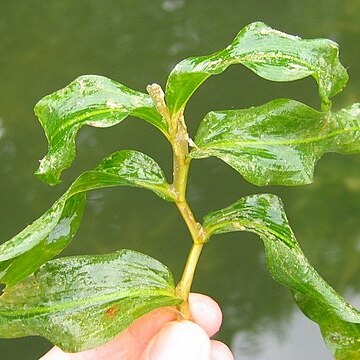Plants perennial, submerged in fresh water. Rhizome spotted, rusty red, slender or sometimes robust, often developing turions at tip. Stems terete, usually elongated, simple or sparsely branched. Stipules axillary, convolute, 1-8 cm, membranous, free from leaf base, usually persistent; leaves sessile, distichous, linear-lanceolate or lanceolate to ovate-oblong or ribbonlike, 6-25 cm, midvein conspicuous, with narrow rows of lacunae bordering midvein, base rounded to cuneate and semiamplexicaul, margin entire, apex often obtuse and markedly cucullate, splitting when pressed. Spikes cylindric, contiguous, with 6-12 whorls of opposite flowers; peduncles 5-80 cm. Carpels 4. Fruit (3.8-)4.5-5.5 mm, abaxial keel distinct; beak erect, 0.6-1 mm. Fl. and fr. Jul-Sep. 2n = 52.
Stems to 3 m, freely branched, usually flexuous or zigzag when the internodes are short (3–5 cm); lvs all submersed, sessile, lanceolate to lance-linear, 8–30 × 1–4.5 cm, obtuse or subacute and usually hooded at the tip, rounded and slightly clasping at base, with 11–35 veins, 3 or 5 of them stronger; stipules axillary, white, scarious, 3–8 cm, free but closely appressed to the stem, persistent, shredding at the tip; peduncles about as thick as the stem, usually elongate, to 5 dm; spikes cylindric, 3–7.5 cm, dense or interrupted; frs obovoid, turgid, 4–5.7 mm, short-beaked, with a sharp, narrow dorsal keel and often 2 obscure or rounded lateral ones; 2n=52. Usually in deep water; circumboreal, s. in Amer. to Conn., Md., Ind., Minn., Colo., and Calif.


